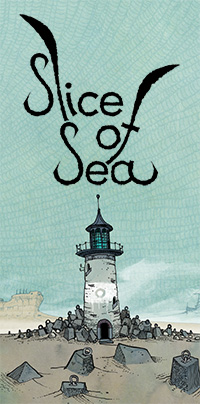Slice of Sea review on Indie Hive
October 23, 2022

Slice of Sea: A Pretty, Pixel-Hunting Point-and-Click Puzzle!
Slice of Sea is a heavily stylised adventure and puzzle game with primarily point-and-click style gameplay. Players take on the role of Seaweed and explore the desolate, dust-filled world in which they must collect items, solve puzzles and lead seaweed back to the ocean!
Players can control Seaweed with keyboard controls (WASD or arrows) and the characters movements are entirely separate from any mouse interactions as Seaweed does not need to be near an item in order for the interaction to take place. There is a fast travel system that can be accessed from specific points throughout the game to speed up travel. It is also impossible to die, if Seaweed falls to their doom they simply respawn at the location that they fell from.
Whilst there is some variety in the puzzles types, including jigsaw, hidden object and environmental, the majority of the game is made up of familiar inventory-based puzzles. Slice of Sea gets off to a good start in this regard but things soon go downhill.
There are very few interactable objects, some of which are not clear at all and easily missable; this means players are left roaming what eventually becomes a vast and sizeable map in search of one, often obscure detail. There is often little logic or direction, the current objective is often unclear and the lack of a viewable map or hint system means there is no assistance if players get stuck. To further confuse matters, a large number of totally useless items can be collected and stored in the inventory so finding something doesn’t necessarily mean progress.
Slice of Sea features no narration, dialogue or text and contains no explicitly delivered narrative. Unfortunately, the wishy-washy attempt at telling a story through the gameplay and environmental elements is vague and speculative at best. Players will probably know from the game’s description that they are helping the protagonist Seaweed back to the ocean but there is nothing to explain who or where the character is, why they need to get back, why there are broken trains and other machines everywhere, etc.
Since there is very little sense of story progression (if any), motivation to trawl through a laborious pixel-hunt across dozens of scenes is stifled further. This also adds further confusion to the gameplay as players have no idea what Seaweed’s goals are beyond eventually reaching the sea.
Slice of Sea’s aesthetics are its best feature and serve as some consolation for the disappointing and often frustrating gameplay. The unique, hand-drawn artwork has a sketchy, cartoon style with lots of detail and texture and charming animation. The moody colour palette of dark, muted shades perfectly match the dusty, desolate environments full of broken machines and helps create a very atmospheric experience.
The music is similarly evocative and consists of mostly melancholy tunes featuring eerie vocals and the distorted twangs of stringed instruments that complement the visuals well. The minimal sound effects are not especially noteworthy but do help to create a more well-rounded environment overall.
Whilst Slice of Sea has some fantastic artwork and music, this is not enough to counter the convoluted nature of the gameplay. This game has the potential to be very confusing, even with the aid of a walkthrough and is, in my opinion, not a great example of a point-and-click game. I’d only recommend it to those with a keen eye for detail, a good memory and the patience to essentially pixel-hunt their way through the game if/when things become too frustrating. I was looking forward to this game and wanted to enjoy it but struggled to do so beyond the first half an hour.
[source]









